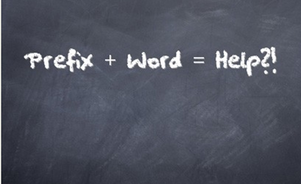 We received a punctuation 9-1-1 yesterday, asking whether or not to hyphenate the prefix "re-."Our answer was, basically, "It depends." The modern aesthetic tries to be a bit critical about when to hyphenate, so that there are not superfluous hyphens eating up real estate on our pages, nor stopping the eye in its course of reading. For the same reason that Write and Polish eschews the serial or "Oxford" comma as unnecessary, we appreciate this style trend. What it means, however, is that not every case is the same. Generally, attach prefixes (and suffixes) to their respective roots, as in nonprofit, semiconscious and multinational. Exceptions — use a hyphen when:
This set of exceptions is not exhaustive, but considers many of the cases that the average person will encounter. If a specific situation with which you've struggled is not addressed here, you may need to consult a dictionary or a style manual appropriate to your business or pursuit. You may also always contact us for clarification or to research a specific language challenge! * As it fell out, yesterday's query turned on that we were instructing someone to "retell a story." So, no hyphen!
0 Comments
 We have encountered postal abbreviations for state names in narrative text quite frequently, of late. So, it seems time for a reminder that while there are a couple of legitimate options when referring in writing to one or more of the constituent parts of these United States of America, the USPS abbreviations are not among them. It's understandable how people can get into the habit of thinking of the state in which they live, and probably also the neighboring ones, to which they are prone to regularly address postal mail, in terms of the postal abbreviations. Though the addressing of mail using the postal abbreviations is ubiquitous, it is still a rare person who knows all fifty of them. When familiarity is not universal, use in text can leave a significant part of the audience wondering if AL refers to Alaska or Alabama. So, it is generally only correct to use a postal abbreviation as part of an actual address block (on an envelope, at the top of a letter, conveying a third-party's address in the body of a letter, anywhere when street/city/ZIP code are present, etc.) Our advice, for the sake of simplicity, is that within text or anything resembling traditional sentence structure, you should write out the name of the state. If you're just looking for a basic instruction, you can probably stop reading now and go about your day. ---------------------------------------------- ~ On the other hand, if you're interested in some of the qualifiers and digressions, continue: In the matter of postal abbreviations, different style manuals handle these things differently. The Chicago Manual of Style (CMOS) prescribes the advice that Write and Polish dispenses above. It is a clean and straightforward solution with nothing to look up or memorize. However, The Associated Press Stylebook (AP) has a set of abbreviations (and non-abbreviations) that it adopts for each state -- the so-called "traditional" abbreviations that pre-dated the postal system's two-letter designations. The majority of newspapers follow AP style, and these handles do clearly convey the necessary information. However, the traditional abbreviations follow no simple rule, like "three letters, first capitalized, ending with a period." They're each their own thing, including the eight that are never abbreviated! So, for the average person writing everyday business or personal material, to follow AP, you would need to refer to a list each time unless you'd learned them. Now, Write and Polish, being concerned about the aesthetic appearance of information on the printed (or rendered) page, writes the state name in its entirety in text AND IN ADDRESS BLOCKS. Though the postal system (their optical readers, actually) wants universal use of its two-letter codes, at present, our preference for what we find to be a more elegant look does not interfere with delivery. We will also admit, when dealing with our own materials, to a streak of obstinacy in the face of government-instituted homogenization! This W&P choice illustrates what is known as "house style." How material is presented can support, detract, or be neutral with reference to the brand and the organization's culture. A business or institution will often choose a major style manual to act as a "base" for its written material, and then supplement it with brand-specific requirements and other exceptions that constitute its own, hopefully distinct, style. House style should still be consistent with understanding, but allows for leeway in a variety of areas. For example, as of this writing, explicit direction to include or exclude the comma before the terminal conjunction in a simple series has become a "house" style point, as in: We color-coded our edits in red, blue, and green. or We color-coded our edits in red, blue and green. The first presentation was once de rigueur, but has largely gone by the wayside as unnecessary and redundant. For those who feel strongly about retaining that comma, however, spelling out the expectation in an internal style manual ensures that it is done consistently throughout the organization. 10/5/2011 0 Comments Writing Tip: Writing NumbersA dear Write and Polish friend consulted us today as to the "rules" of numbers -- of writing them as words versus using the numerals. Our advice was:
The simplest guide is that numbers below 10 are written, and those 10 and above are in numerals. But there are many exceptions, for
|
Write and Polish BloggersChristie Manussier, principal Writer and Polisher, is the usual news reporter. CategoriesAll Abbreviation Academic Acronym Adjective Adverb Anachronism Anagram Apostrophe Application Article Banished Biography Blend B.N.I. Boldface Brochure Bunnies Business Business Plan Capitalization Children's Literature Christmas Church Comma Common Mistakes Construction Contact Management Content Contest Cross-sell Databse Differentiators Donation Double Negative E-mail Entertainment Etymology Event Coordination File Format First Reference Flyer Fundraiser Giggles Gold Star Grammar Day Grant Proposal Haiku Health Care Homophones Hyphen Idiom Images Italics Law Firm Magazine Manual Marketing Maternity Leave Metaphor Myth News & Announcements Newsletter Non Profit Non-profit Noun Numbers Of Snakes And Presidents Parts Of Speech P.D.F. Plural Poetry Portmanteau Poster Powerpoint P.R. Preposition Press Release Projects Pronoun Proofreading & Editing Punctuation Quotation Marks Quotes Real Estate Recommended Reading Reflexive Research Resources Restaurant Retail R.F.P. R.I.P. Shakespeare Slideshow Social Media Spelling Style Manual Synonyms Syntax Template Tenses Testimonial Thesaurus Training Manual Translation Travel Twitter Underlining Verb Video Vocabulary Website Why The World Needs More Proofreaders Winter Word Of The Day Writers Writing Tip Archives
March 2015
|
Search by typing & pressing enter

 RSS Feed
RSS Feed